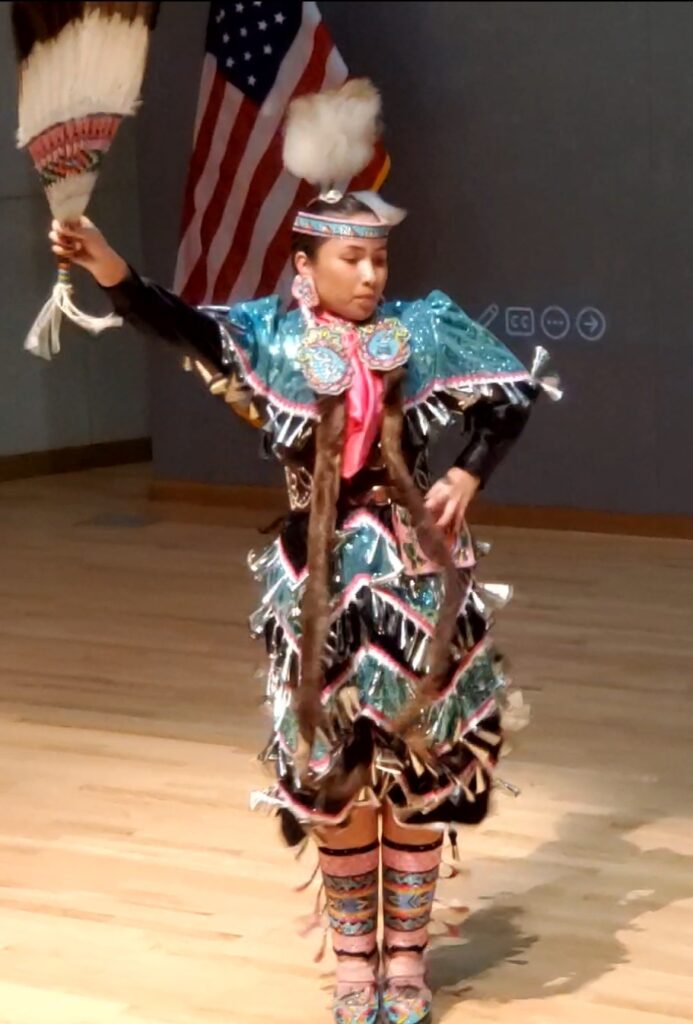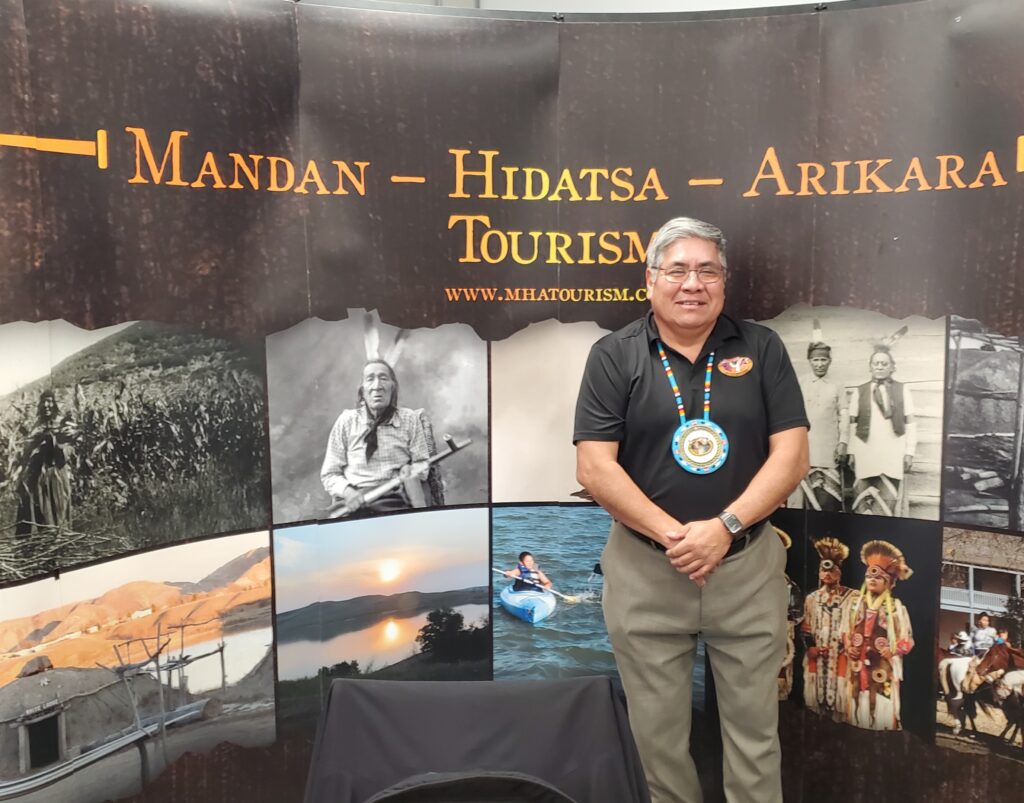Hundreds of students, teachers, and community members listen intently to Charlie Moran as he explains the cultural significance behind each powwow dance and the regalia worn by the dancers who are citizens of the Three Affiliated Tribes, also known as the Mandan Hidatsa Arikara (MHA) Nation, on the Fort Berthold Indian Reservation in central North Dakota. “This is the jingle dance. Each jingle represents a prayer,” he says. He goes on to share the story of how the jingle dress dance was created.
Moran is one of several storytellers and culture bearers at the first annual Native American Heritage Month celebration created by the North Dakota Native Tourism Alliance (NDNTA), the MHA Nation and the State Historical Society of North Dakota (SHSND). Sessions were offered throughout the day at the North Dakota Heritage Center in Bismarck for local schools and community members to witness this event highlighting one of the five Native Nations within North Dakota borders. Over the next several years, they plan to co-host cultural events with each of the tribal nations during Native American Heritage Month.
Stacey LaCompte (Standing Rock), Executive Director of NDNTA“NDNTA is unique in that it is the first of its kind to form partnerships with all five Native Nations—working together to promote, build and enhance sustainable economies through tourism.”

Taking Back the Narrative
The NDNTA, founded in 2016, is a nonprofit organization committed to protecting, preserving, promoting, and educating the world about the culture, history, and environment of the five Native Nations: the Spirit Lake Nation, Standing Rock Sioux Tribe, Mandan Hidatsa Arikara Nation, Sisseton Wahpeton Oyate, and the Turtle Mountain Band of Chippewa Indians.
“NDNTA is unique in that it is the first of its kind to form partnerships with all five Native Nations—working together to promote, build and enhance sustainable economies through tourism,” says NDNTA Executive Director Stacey LaCompte (Standing Rock).
In 2022, the organization was awarded the North Dakota Governor’s Trailblazer Award for Tourism Innovation. That year it also received a Bush Foundation Community Innovation grant to develop and test a new model of tourism that creates tour packages specific to and created by Native Nations within the state’s borders. The award-winning model aims to combat a history of colonizing narratives and practices within the tourism industry.
In North Dakota, it is non-Native entities driving the narrative and in more cases than not, they own the sites most frequently encountered within tourism experiences. NDNTA’s work is driven by a desire to reclaim Native narratives of history and culture and allow Indigenous people to tell their own stories, in their own words.

The cities of Bismarck and Mandan lie on the ancestral lands of the MHA Nation that spans across the Missouri River basin, from present day North Dakota through western Montana and Wyoming. Double Ditch Indian Village and Chief Looking’s Village in Bismarck—sites that are sacred and historical to the MHA Nation—are currently run by the state historical society and Bismarck Parks and Recreation, respectively. The NDNTA wants to change such narratives by supporting Indigenous nations to tell their own stories through the use of interpretive centers and cultural events that benefit visitors and the tribal communities alike.
Tourism events like the one in partnership with NDNTA are helping to sustain a healthy economy. “Events like this educate the community about who we are,” LaCompte says. “They (the MHA Nation) reached out to their storytellers to tell their creation stories…They (the tribes) bring culture, art and food, as well as entrepreneurs who sell their handmade goods. It keeps people in their community employed by showing their culture.”
Each tribe is responsible for developing their tourism office, designing their own itineraries, employing storytellers, dancers, artists and other staff. Each tribe works at their own pace, and it is anticipated that all tribes will be online and their tours will be ready to book within the next few years.
Breaking Down Barriers
The NDNTA is made up of two citizens from each tribal nation serving as voluntary board members. Darian Morsette (MHA) serves as the board’s president and also as the Tourism Director for the MHA Nation. He says offering Native American cultural learning and tourism opportunities are crucial for educating non-Native communities. “Bringing in schools, having them see the history first hand, they see that they can engage with us. The more we are educating, the more we are telling our stories, and the more visible and impactful that will be on the non-Native community.”
NDNTA Vice President Les Thomas (Turtle Mountain Band of Chippewa Indians) says that the nonprofit is breaking down several misconceptions of Indigenous peoples. One of those being, that all tribes are the same. “Every tribe has its own history to tell, its own language and its own culture to share. With the North Dakota Native Tourism Alliance, we have the opportunity to use our own voices to tell our stories, which isn’t something you will find in textbooks.”




Another common misconception about Native tourism is that many non-Native people believe that they aren’t allowed in reservations. Thomas says this simply isn’t true. The organization wants to encourage the public “to come to the reservation and experience these immersive and educational tours for themselves.”
Indigenous Tourism in Demand
Morsette says there is a demand to learn about Indigenous cultures from the U.S. “Our partners are seeing that we are moving forward and are seeing the steps we are taking to get noticed. That’s paying off for attaining international clients. There are training sessions for us to learn how to market and price our tours. Native Country is in demand in European countries, as well as Asia and Australia.”

The NDNTA has been working closely with each tribe over the last several years, even through the pandemic. They have accomplished a lot, and as Executive Director Stacey LaCompte says, their work is finally getting recognized. “We are building collaborations within tribal nations by having all five nations on board, understanding the benefits of developing sustainable economies through tourism. NDNTA is a hub, the center to bridge all tribes with the common goal of building economies.”
For Morsette, it’s been important to build relationships with entities who have supported the organization and believed in the idea of ‘Native tourism.’ He says that George Washington University has provided them technical assistance, guidance and expertise, “as well as North Dakota Tourism, tour operators and local convention and visitors bureaus. We are now using what we have learned to start making waves and get noticed around the state.”
To learn more about the NDNTA, visit https://www.ndnta.com/who-we-are, reach out to NDNTA Executive Director Stacey LaCompte at 605-280-8588, or call the MHA Tourism office at 701-627-2243.
